Advertisements
Advertisements
प्रश्न
In the figure given alongside, squares ABDE and AFGC are drawn on the side AB and the hypotenuse AC of the right triangle ABC.
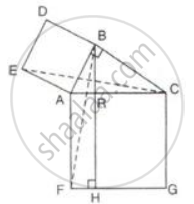
If BH is perpendicular to FG
prove that:
- ΔEAC ≅ ΔBAF
- Area of the square ABDE
- Area of the rectangle ARHF.
उत्तर
(i) ∠EAC = ∠EAB + ∠BAC
∠EAC = 90° + ∠BAC ...(i)
∠BAF = ∠FAC + ∠BAC
∠BAF = 90° + ∠BAC ...(ii)
From (i) and (ii), we get
∠EAC = ∠BAF
In ΔEAC and ΔBAF, we have, EA = AB
∠EAC = ∠BAF and AC = AF
∴ ΔEAC ≅ ΔBAF ...(SAS axiom of congruency)
(ii) Since ΔABC is a right triangle, We have,
AC2 = AB2 + BC2 ...(Using pythagoras theorm in ΔABC)
⇒ AB2 = AC2 - BC2
⇒ AB2 = (AR + RC)2 - (BR2 + RC2) ...(Since AC = AR + RC and Using Pythagoras Theorem in ΔBRC)
⇒ AB2 = AR2 + 2AR × RC + RC2 - (BR2 + RC2) ...(Using the identity)
⇒ AB2 = AR2 + 2AR × RC + RC2 - (AB2 - AR2 + RC2) ...(Using Pythagoras Theorem in ΔABR)
⇒ 2AB2 = 2AR2 + 2AR × RC
⇒ AB2 = AR(AR + RC)
⇒ AB2 = AR × AC
⇒ AB2 = AR × AF
⇒ Area (`square`ABDE) = Area(rectangle ARHF).
APPEARS IN
संबंधित प्रश्न
In the given figure, if the area of triangle ADE is 60 cm2, state, given reason, the area of :
(i) Parallelogram ABED;
(ii) Rectangle ABCF;
(iii) Triangle ABE.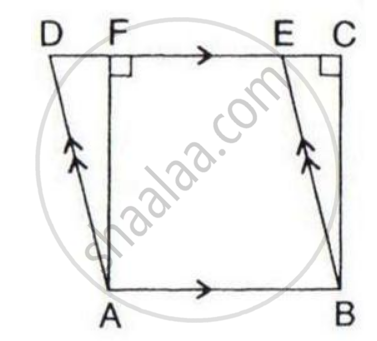
ABCD is a trapezium with AB // DC. A line parallel to AC intersects AB at point M and BC at point N.
Prove that: area of Δ ADM = area of Δ ACN.
In the given figure, D is mid-point of side AB of ΔABC and BDEC is a parallelogram.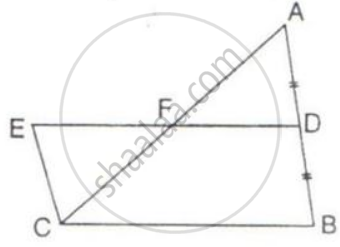
Prove that: Area of ABC = Area of // gm BDEC.
ABCD and BCFE are parallelograms. If area of triangle EBC = 480 cm2; AB = 30 cm and BC = 40 cm.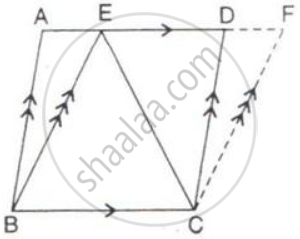
Calculate :
(i) Area of parallelogram ABCD;
(ii) Area of the parallelogram BCFE;
(iii) Length of altitude from A on CD;
(iv) Area of triangle ECF.
In parallelogram ABCD, P is a point on side AB and Q is a point on side BC.
Prove that:
(i) ΔCPD and ΔAQD are equal in the area.
(ii) Area (ΔAQD) = Area (ΔAPD) + Area (ΔCPB)
ABCD is a parallelogram a line through A cuts DC at point P and BC produced at Q. Prove that triangle BCP is equal in area to triangle DPQ.
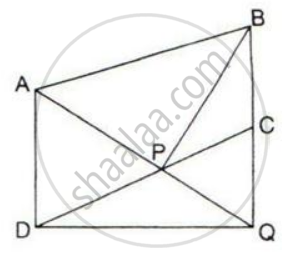
The given figure shows a pentagon ABCDE. EG drawn parallel to DA meets BA produced at G and CF draw parallel to DB meets AB produced at F.
Prove that the area of pentagon ABCDE is equal to the area of triangle GDF.
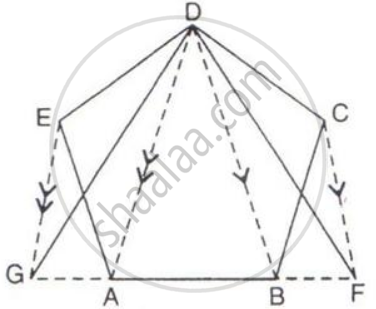
In the following figure, BD is parallel to CA, E is mid-point of CA and BD = `1/2`CA
Prove that: ar. ( ΔABC ) = 2 x ar.( ΔDBC )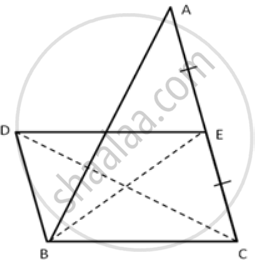
In ΔABC, E and F are mid-points of sides AB and AC respectively. If BF and CE intersect each other at point O,
prove that the ΔOBC and quadrilateral AEOF are equal in area.
Show that:
The ratio of the areas of two triangles on the same base is equal to the ratio of their heights.
